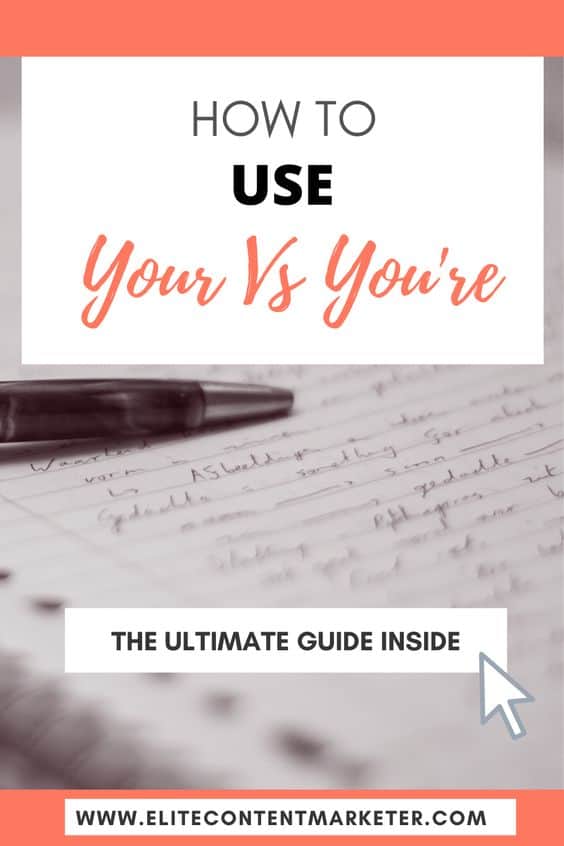English grammar is a difficult nut to crack. Even the most well-versed in the rules of grammar can sometimes mess things up while speaking or writing in the language. One pair of words that can be confusing is “your vs. you’re.”
Both words are pronounced the same way, and also look similar – with just an apostrophe making all the difference. But even if they sound the same and look like fraternal twins, they serve two distinct and different purposes.
People end up confusing the two more often than not, which could end up weakening your text or speech and making it harder for others to connect with you. Don’t worry – if you’re getting your words mixed up, I am here to help with the basics:
“Your” is a possessive adjective that shows that you possess a noun.
- For example: That’s not my house. That’s your house.
And, “you’re” is simply a short way of writing “you are.”
- For example: Thank you so much! You’re awesome!
Now, let us dive into the specifics of how each of these words is used:
Note: This article contains affiliate links. It means if you sign up using my link, then I earn a commission (at no extra cost to you). I only recommend products that I personally find valuable and enjoy. I appreciate your support!
Recommended reading: Who Or Whom: How To Get It Right Every Time
Your Is ‘Possessive’ (And Its Other Use Cases)
Your, simply put, is the possessive form of “you,” the second-person pronoun. It is always used to denote something belonging to the person being spoken to and can be used in both singular and plural forms.
The word “your” can be followed by a noun or a gerund. A noun is a word that names a person, a place, a thing, or an idea. A noun can tell who or what. A gerund, on the other hand, is derived from a verb (so it ends with –ing), but it functions as a noun.
For example: “your dress” or “your dancing.”
In addition, many expressions and idioms make use of possessive adjectives. Below are a few common examples:
1. A penny for your thoughts
The idiom is used to ask someone what they are thinking about.
Example: Meghan, you look thrilled today. A penny for your thoughts?
2. As plain as the nose on your face
The expression is used to highlight something obvious.
Example: I knew what she was up to—it was as plain as the nose on her face.
3. At your service
This is a hospitable expression, which means to be ready to help someone whenever possible.
Example: Good afternoon – welcome to Rosebud Hotel. I am David, and I am at your service.
5 Examples Of How To Use ‘Your’
The word “your” lets us know to whom the noun belongs and comes before a noun in the sentence.
1. Is that your dog on the pavement?
2. Your teacher was telling me how much your grades have improved.
3. Your book is on the table.
In the above examples, dog (thing), teacher (person), grades (thing), and book (thing) are nouns; hence, the use of “your.”
Similarly, here’s how to use “your” in a sentence before a gerund.
4. Your working so late every day is causing some problems at home.
5. I can’t wait to taste your cooking again.
‘You’re’ Is A Contraction
As explained before, “you’re” is a contraction for “you are,” but the difference is that it only fits in informal writing. “You’re” can be followed by a noun, an adjective, or a present participle. Like “your,” several expressions and idioms use “you’re,” some of which are below:
1. You’re on!
An expression used to show agreement. In other words, “let us do it.”
Example: Did you challenge me to another game of table tennis? You’re on!
2. You’re welcome
This denoted the informal way of saying, “you are welcome.”
Example: You’re welcome. I am always happy to help!
3. You’re telling me!
An empathic way of saying, “I know.”
Example: Did you just say that it’s hot outside? You’re telling me! I can’t even bear to go out right now.
5 Examples Of How To Use ‘You’re’
Apart from being a contraction of “you are,” the word has no other uses. The examples below highlight that:
1. You’re not going anywhere before doing the laundry.
2. I can’t believe you’re here.
3. You’re taking part in the talent show, aren’t you?
4. You’re wearing that dress inside out.
5. While you’re at it, take out the trash for me, please.
Recommended reading: How To Use Semicolons: A Simple Guide
3 Simple Tips For Using Your vs. You’re
It’s easy to confuse “your” and “you’re,” especially since they are pronounced the same way.
1. “Your” is always followed by a noun or a gerund.
Here’s an example: “Eat your vegetables” or “Your singing is off-key.”
If the word is followed by any other part of speech, such as an adjective or a verb, the word to use is “you’re.” That means “Your beautiful” or “Your running too fast” is incorrect, but “You’re beautiful” and “You’re running too fast” are correct.
2. When in doubt: replace “your” with “my” in the sentence.
If you can so that and still be grammatically correct, your usage of “your” is proper. For example, if the sentence is “Your suitcase is missing,” and we replace “your” with “my” to write “My suitcase is missing,” the sentence is still correct.
However, if the sentence is “You’re not eating enough,” then the replacement would read as “My not eating enough,” which does not make sense. So, in this case, the word to use is “you’re.”
3. Unable to expand “you’re” in a sentence, avoid.
And here’s the most straightforward rule of all. If you cannot expand “you’re” to “you are” in your sentence, the word you should use is “your.”
Final Thoughts
Confusing “your” with “you’re” might seem like a minor mistake, but correct grammar can go a long way in enhancing people’s impressions of you. Be sure to reread your text carefully and use the tips I have shared above to identify any mistakes.
With a little practice, you will be well on your way to grammatical stardom. Up next, read more writing tips and explore writing exercises.


